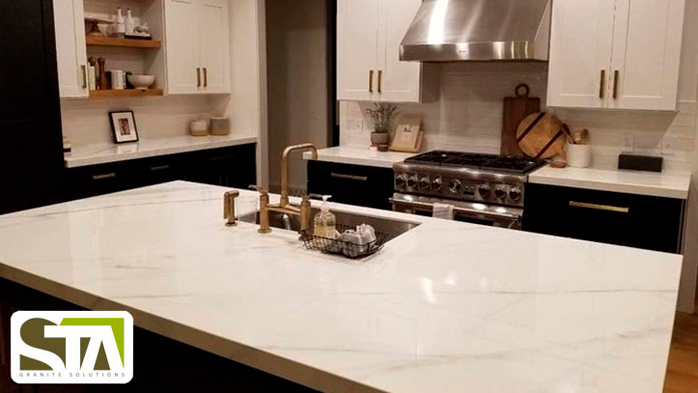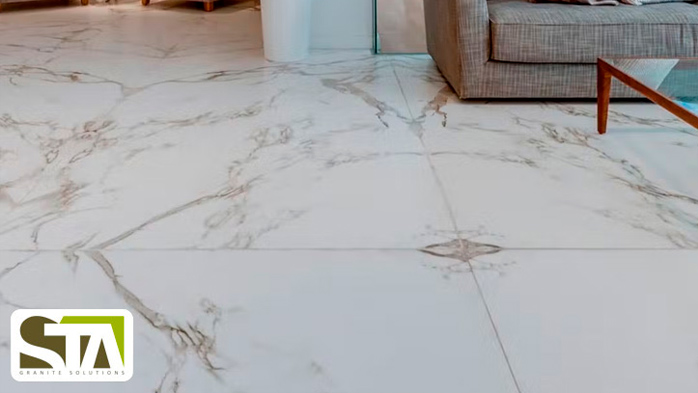HOW TO REINFORCE STONE COUNTERTOPS, PORCELAIN, DEKTON, QUARTZ, MARBLE, ETC. PT 3

There are several choices when it comes to rodding. If you use steel rodding, be sure to use rodding that has no rust, is free of moisture, and is completely encased in epoxy when it is used. Or, use a rodding made of rust-proof material such as the ones mentioned above.
Splines
Seams are unavoidable in some projects. Additionally, there are occasions where strengthening them is important and recommended by some fabricators. Using splines is another way of reinforcing stone. Using a "spline key" that is installed according to the rust protection methods described above strengthens the seam by reinforcing the stone.
Spline keys are commonly in the form of a large washer. The washer is inserted into a slot that is cut in the ends of the two stone pieces that join to make the seam. The slots are cut at the midway point measuring from the top of the slab. The spline key is encased in epoxy and reinforces the seam. If the washer used as the key is made from steel, the techniques mentioned above for the steel rodding must be used for steel spline keys as well.
Liner Blocks
The last reinforcement technique that we will briefly mention is the use of linear blocks to reinforce the stone. This technique for stone reinforcement is not used often but it is used.
Bonding a linear block of stone (matching or non-matching) to the underneath part of the stone to support the seam is how this technique is used. This is done when no sub-top is used.
The reinforcement techniques we have mentioned in this article are used either alone or in tandem to strengthen the stone countertop. Why? Because natural stone is well, natural.


Therefore, each slab will vary in strength, and the properties of the two stones will behave differently from one another. Also, removing sections of the stone causes areas to be weaker and needs reinforcing. So, knowing about these reinforcement techniques is essential for anyone fabricating with these materials.
In the end, you will find that there are a variety of ways to apply these techniques and that fabricators will use one or more of them depending on the situation, the stone, and even specific design techniques and elements in the project. So, gain knowledge and experience if you are new to the craft. And if you are the one with the experience, share your knowledge and wisdom with others. By doing so, you will contribute to the overall good reputation of the natural stone industry through the high-quality workmanship that will result!
The importance of having adequate equipment to cut dekton and porcelain
Why do products such as Dekton need special/different tools than those that are used for cutting granite and marble?
Material hardness is the key to understanding why you need different tools to fabricate Dekton. The material has a
The cutting process requires trimming the edges to release tensions. Then you have to follow cutting recommendations, which include using plenty of water, the proper speed, feed rate, etc. Once you follow the rules, it’s a piece of cake.


In this sense, Dekton’s edge is very easy to work with since the material is very homogeneous, and it is easy to get very good results. Any fabricator can do it well on the first attempt.
What are some common mistakes that fabricators are making when it comes to cutting this material? And, what are some common mistakes with doing edging or doing sinkholes or something?
The main mistake is trying to fabricate Dekton as if it was a granite or quartz composite. You will fail if you use the same tools, speed rates, and so on. Another common mistake is trying to cut Dekton in uneven support. It is a common source of problems too.
Sometimes people ask about what machine is best to cut Dekton. I believe the key is not the machine but the tools and proper maintenance. I have seen people with very modest equipment doing amazing things and the other way around.
7 Keys for Cutting Ultra-Compact and Sintered Dekton and Porcelain Materials







It may seem too simple or too intuitive to matter, but less than adequate water AND hoses positioned incorrectly is the most common error causing headaches among cutting these materials.
One of the more overlooked aspects of successful cutting is, to the degree that your table is not level in the horizontal plane, vibrations will occur. This unevenness can result in chipping and likely breaking the edge of your slab.
As cliche, as it may sound, choosing the right blade for the material you are processing, is critical.
While each manufacturer of ultra-compact and sintered porcelain materials may, or may not have tensioning strips built into the perimeters of each slab, if they are not removed before cutting, the slab is at higher risk of cracking or breaking.
Using the same feed rate and RPMs you may be accustomed to when cutting other materials can be a recipe for trouble. Unlike fabricating more common materials such as marble and granite, we’ve seen the most success cutting ultra-compact and sintered porcelain materials when following a systemized approach is used.
While plunge cutting tends to be of little concern for most sawyers when cutting ultra-compact and sintered porcelain materials it can pose big problems resulting in cracking or breaking your slab.
Projects requiring a sink cut-out can be an obstacle many fabricators dread. Since we already know plunging is not the ideal way to go about this, what are your options? When preparing a sink cut-out, it is advised to drill each of the four corners with a 1/2” core bit before to start initiating cutting.

PORCELAIN FOR YOUR HOME, TILES

PORCELAIN FOR YOUR HOME, COUNTERTOPS FOR YOUR KITCHEN

DEKTON FOR YOUR HOME, FLOORS, AND PAVEMENTS
- 1
- 2
- 3
- 4
- 5
- 6
- 7
- 8
- 9
- 10
- 11
- 12
- 13
- 14
- 15
- 16
- 17
- 18
- 19
- 20
- 21
- 22
- 23
- 24
- 25
- 26
- 27
- 28
- 29
- 30
- 31
- 32
- 33
- 34

